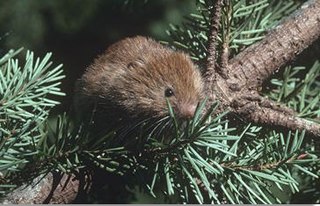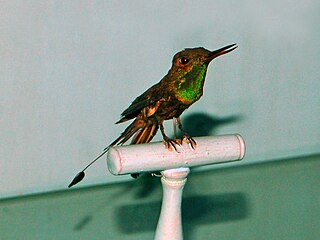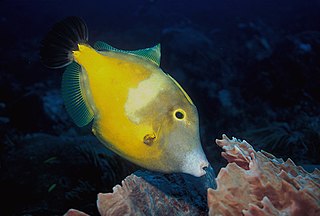
Pterodactylus is an extinct genus of pterosaurs. It is thought to contain only a single species, Pterodactylus antiquus, which was the first pterosaur to be named and identified as a flying reptile and one of the first prehistoric reptiles to ever be discovered.

The long-tailed skua or long-tailed jaeger is a seabird in the skua family Stercorariidae.

Rhamphorhynchus is a genus of long-tailed pterosaurs in the Jurassic period. Less specialized than contemporary, short-tailed pterodactyloid pterosaurs such as Pterodactylus, it had a long tail, stiffened with ligaments, which ended in a characteristic soft-tissue tail vane. The mouth of Rhamphorhynchus housed needle-like teeth, which were angled forward, with a curved, sharp, beak-like tip lacking teeth, indicating a diet mainly of fish; indeed, fish and cephalopod remains are frequently found in Rhamphorhynchus abdominal contents, as well as in their coprolites.

Microtus is a genus of voles found in North America, Europe and northern Asia. The genus name refers to the small ears of these animals. They are stout rodents with short ears, legs and tails. They eat green vegetation such as grasses and sedges in summer, and grains, seeds, root and bark at other times. The genus is also called "meadow voles".

The long-tailed vole, in some areas known as the San Bernardino long-tailed vole, is a small vole found in western North America. They have short ears and a long tail. Their fur is gray brown with light gray underparts. They are around 18 cm (7.1 in) long with an 8 cm (3.1 in) tail and weigh about 50 g (1.8 oz).

The genus Arborimus is a group of voles found in western North America. The genus name is Latin for "tree mouse". Some sources include this genus with the heather voles, genus Phenacomys, and both are classified in the tribe Phenacomyini.

Yandangornis is a genus of theropods from the Late Cretaceous Tangshang Formation of China. It lived 81.5 million years ago in what is now China. The type species, Y. longicaudus, was formally described by Cai and Zhou in 1999.

The red tree vole is a rodent of the Pacific Northwest, found in the US states of Oregon and California. They were formerly known as Phenacomys longicaudus and have also been called the red tree mouse.

The racket-tailed coquette is a species of hummingbird in the family Trochilidae native to northern South America.
The long-tailed gracile mouse opossum is a species of opossum in the family Didelphidae. It is endemic to Colombia.

Pleistodontes is a genus of fig wasps native to Australia and New Guinea, with one species from Java. Fig wasps have an obligate mutualism with the fig species they pollinate. Pleistodontes pollinates species in section Malvanthera of the Ficus subgenus Urostigma.
Androlaelaps fahrenholzi is a species of mite in the genus Androlaelaps of the family Laelapidae. It occurs throughout the contiguous United States, where it has been recorded on the following mammals:
The longtail cusk is a species of viviparous brotula native to the reefs around Australia. This species grows to a length of 5.8 centimetres (2.3 in) SL.

Cantherhines is a genus of filefishes.
Geiseltaliellus is an extinct genus of iguanian lizards that lived in what is now western Europe during the Eocene. It belongs to the family Corytophanidae, which includes modern casquehead lizards. Many fossils are known from Germany, France, and Belgium, with the most well preserved coming from the Messel pit lagerstätte in Messel, Germany. German paleontologist Oskar Kuhn named the genus in 1944 after the Geiseltal valley where the first specimens were found, designating the type species Geiseltaliellus longicaudus. Three new species — G. louisi, G. lamandini, and G. grisolli — were named in the 1990s and 2000s on the basis of more fragmentary remains from France and Belgium, although G. louisi has since been synonymized with G. longicaudus. In 2009 the Messel pit specimens were recognized as belonging to a species distinct from that of the G. longicaudus specimens in Geiseltalt and were collectively reclassified under a new name, G. maarius.

Brachynemurus is a genus of antlions in the family Myrmeleontidae. There are at least 20 described species in Brachynemurus.
Symphyothrips is a genus of thrips in the family Phlaeothripidae.
Kompsornis is an extinct genus of avialan that lived during the Early Cretaceous period of China. The type and only known species is Kompsornis longicaudus; the specific name means "long-tailed". It is known from only a single fossil specimen from the Jiufotang Formation. Kompsornis was closely related to the well-known Jeholornis, another long-tailed avialan from China, but differs from it in features of its skeleton, particularly the fusion and growth rate of its bones. Like other jeholornithiforms, Kompsornis was a long-tailed avialan with long wings and possessed little or no teeth, with none identified in the single specimen of Kompsornis.

Phenacomyini is a tribe of voles in the subfamily Arvicolinae. It contains five species in two genera, all of which are found in North America.
Racket-tail is the common name for a genus of parrots (Prioniturus) from south-east Asia.












